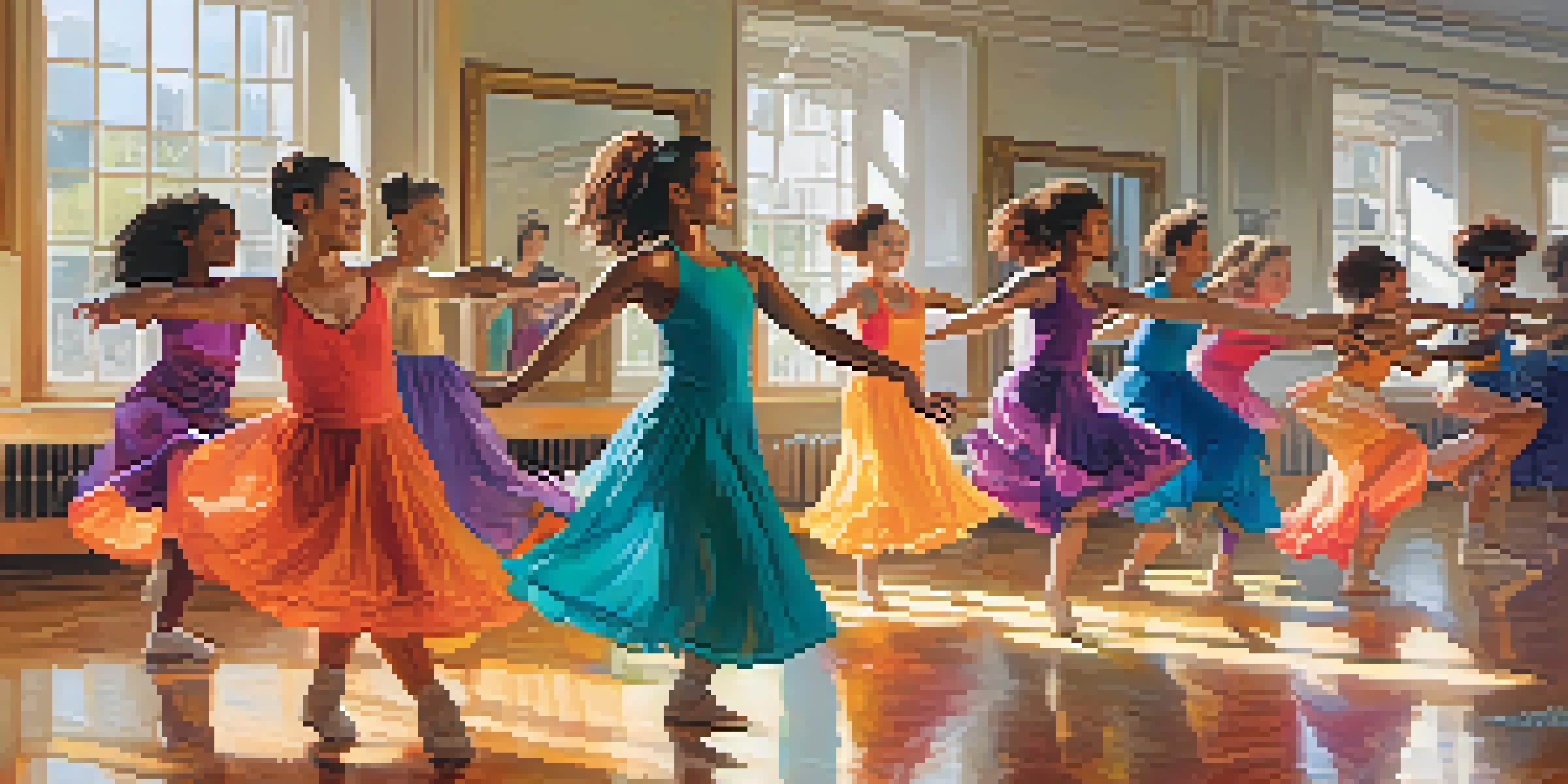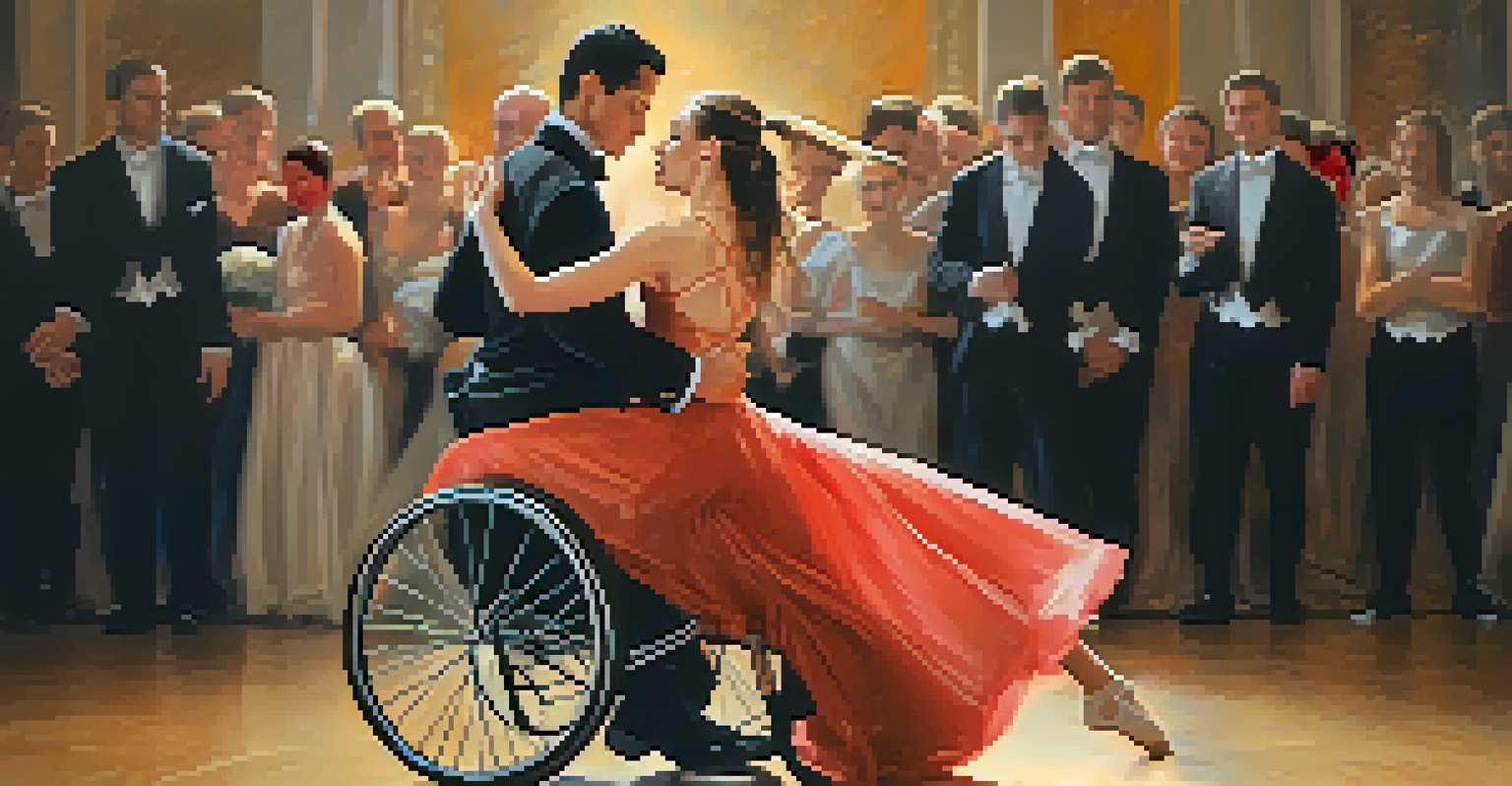The Evolution of Adaptive Dance: A Historical Perspective

Understanding Adaptive Dance and Its Importance
Adaptive dance refers to movement practices that cater to individuals with varying abilities, ensuring inclusivity and expression. Its importance lies not just in physical movement but also in fostering emotional and social connections among participants. Just like how a chameleon adapts to its environment, adaptive dance allows dancers to find their unique rhythm and voice, regardless of their challenges.
Dance is the hidden language of the soul.
The roots of adaptive dance can be traced back to the early 20th century when dance began to be recognized as a therapeutic tool. Initially, these practices were informal, often occurring in community settings where individuals with disabilities could come together. This laid the groundwork for the structured approaches we see today, showcasing the power of movement as a means of expression and healing.
Today, adaptive dance has evolved into a recognized art form, providing opportunities for creativity and personal growth. It promotes not only physical health but also mental well-being, helping participants develop confidence and a sense of belonging. The journey of adaptive dance is a testament to how art can break down barriers and create a more inclusive world.
The Early Beginnings of Adaptive Dance Practices
In the early 1900s, pioneers in dance therapy began to explore how movement could support individuals with disabilities. One of the first notable figures was Mary Wigman, who emphasized the therapeutic aspects of dance, paving the way for future innovations. These early practices were often trial-and-error, driven by a desire to create a space where everyone could enjoy dance.

As awareness grew, so did the methods of incorporating adaptive techniques into dance. The 1940s and 50s saw the emergence of specialized programs that tailored dance instruction to various needs. Think of this period as the seed stage, where the idea of adaptive dance was nurtured and began to take root in communities across the globe.
Adaptive Dance Promotes Inclusivity
Adaptive dance fosters emotional and social connections, allowing individuals with varying abilities to express themselves through movement.
By the 1960s, adaptive dance was starting to gain traction, with organizations forming to promote inclusive practices. Workshops and performances became more common, highlighting the potential of dance as a universal language. This shift not only brought attention to the needs of dancers with disabilities but also celebrated their talents and contributions to the art form.
Key Figures Who Shaped Adaptive Dance
Throughout the history of adaptive dance, several key figures have emerged, each contributing their unique vision and passion. One notable name is Alito Alessi, who founded the Dancing Wheels Company, blending disabled and non-disabled dancers to create powerful performances. His work exemplifies the spirit of collaboration, showing that dance can transcend physical limitations.
The body says what words cannot.
Another influential figure is Judith Smith, who co-founded AXIS Dance Company, a trailblazer in the field of physically integrated dance. Her approach emphasizes the importance of collaboration and artistic expression between dancers of all abilities. Like a master conductor, she orchestrates a symphony of movement that resonates with audiences and participants alike.
These pioneers and many others have not only advanced the field of adaptive dance but have also inspired countless individuals to explore their own dance journeys. Their contributions remind us that adaptive dance is not just about accommodating differences; it's about celebrating diversity and the beauty of human expression.
The Role of Technology in Adaptive Dance Evolution
With the rise of technology, adaptive dance has experienced a transformative evolution. Tools like virtual reality, motion capture, and specialized choreography software have opened new avenues for creativity and accessibility. Imagine a dancer using a VR headset to explore different environments, expanding their imagination and movement possibilities without physical constraints.
Assistive devices and adaptive equipment have also played a significant role in enhancing the dance experience. From wheelchairs designed for dance to wearable technology that tracks movement, these innovations make dance more accessible for everyone. It's as if technology has become a dance partner, supporting and amplifying the unique abilities of each dancer.
Therapeutic Benefits of Dance
Engaging in adaptive dance enhances physical coordination and mental well-being, providing a powerful outlet for healing and personal growth.
Furthermore, online platforms have made it easier for adaptive dance communities to connect and share resources across the globe. Virtual classes and performances have become a lifeline, especially during challenging times, allowing dancers to continue their passion and connect with others. Technology, therefore, acts as a bridge, linking people and ideas in the ever-evolving world of adaptive dance.
Adaptive Dance in Education and Community
Adaptive dance has found a significant place in educational institutions and community programs, enriching the lives of participants. Schools now recognize the value of inclusive dance programs that cater to diverse learners, fostering a sense of belonging and teamwork. Picture a classroom where students of all abilities come together to create a dance routine, learning from each other's strengths and perspectives.
Community centers and organizations also play a pivotal role in promoting adaptive dance, offering classes and workshops tailored to various needs. These programs not only teach dance but also build confidence and social skills, empowering individuals to express themselves freely. Just as a garden flourishes with diverse plants, these inclusive environments cultivate creativity and joy.
Furthermore, collaborative projects involving adaptive dance foster connections between artists and the community. They create opportunities for performances that showcase the talents of all participants, breaking down stereotypes about disabilities. The impact is profound, as these initiatives inspire others to appreciate the beauty of diversity in movement and artistry.
Adaptive Dance and Therapeutic Benefits
The therapeutic benefits of adaptive dance cannot be overstated, as it serves as a powerful tool for healing and personal growth. Engaging in dance can enhance physical coordination, flexibility, and strength, while also improving mental health and emotional well-being. Think of it as a gentle wave, washing over the dancer and soothing their mind and body.
Research has shown that dance therapy can help reduce anxiety, depression, and stress, creating a positive impact on participants' lives. The rhythmic movements and expressive nature of dance provide an outlet for emotions, allowing individuals to connect with their inner selves. Like a melody that resonates in one's heart, dance offers a unique way to navigate life's challenges.
Future Trends in Adaptive Dance
As awareness of inclusivity grows, adaptive dance is set to evolve with innovative collaborations and diverse performances embracing all abilities.
Moreover, adaptive dance promotes socialization and camaraderie among participants, fostering friendships and support networks. These connections can be invaluable, creating a sense of community that further enhances the therapeutic experience. In this way, adaptive dance becomes not just a practice, but a lifeline that nurtures the soul.
The Future of Adaptive Dance: Trends and Possibilities
As we look to the future, the possibilities for adaptive dance are vast and exciting. With growing awareness and advocacy for inclusivity in the arts, more opportunities are emerging for dancers of all abilities. This could lead to an even greater variety of performances, showcasing the unique talents of adaptive dancers on stages worldwide.
Collaboration between artists, educators, and technologists is likely to drive innovation in adaptive dance. Emerging trends such as interdisciplinary projects could blur the lines between dance, visual arts, and technology, creating immersive experiences for audiences. Imagine a performance that combines dance with interactive installations, inviting viewers to participate in the artistic journey.

Ultimately, the future of adaptive dance hinges on continued advocacy and support for inclusive practices. By fostering environments where everyone is encouraged to express their creativity, we can ensure that adaptive dance continues to thrive. Just as a river flows and adapts to its surroundings, adaptive dance will evolve, embracing diversity and inspiring generations to come.